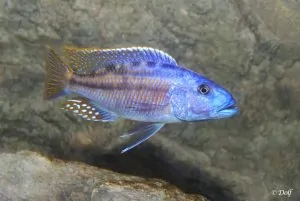Pseudotropheus johannii, Bluegray Mbuna
“Arnoldia Rhodesia (1973), n° 16, vol. 6, pp. 4-7”. Pseudotropheus johannii was initially described as Melanochromis johannii. However, due to differences in the way the stripes are displayed on the flank, they can no longer be considered as Melanochromis. They have therefore been placed back in the catch-all genus Pseudotropheus, conceivably until they get a new genus name. Their common name is Bluegray Mbuna or Johanni Cichlid.
Related species
Melanochromis interruptus, Melanochromis perileucos, Melanochromis cyaneorhabdos.
Distribution
Endemic species from Lake Malawi. The type species was found in the southern part of the lake, at Cape Ngombo, along the eastern shore. Meanwhile, Pseudotropheus johannii was also found in various other places along the east coast, far into Mozambique.

Size
Males can grow up to about 10 centimetres; females remain slightly smaller.
Body shape
The body of Pseudotropheus johannii is slender, elongated and only moderately compressed laterally. The shape of the body, as well as the blunt snout and the steeply rising forehead, are almost identical to Melanochromis auratus. Relatively small mouth and lower jaw slightly shorter than the upper jaw.
Color and markings
Females, as well as young animals, are coloured orange-yellow, with indistinct traces of two dark longitudinal bands on the body. The first rays of the pelvic fins and the outer rim of the anal fin are coloured white. A dark blue band runs through the dorsal fin in the spiky part. The males are blue-black. There are two bright blue cross bands on the forehead, one between and one above the eyes. The latter extends as a longitudinal band across the body to the base of the caudal fin. A second longitudinal band starts behind the gill cover, above the pectoral fins. A row of light blue spots at the base of the dorsal fin also forms a longitudinal band. The first rays of the pelvic fins and the outer edge of the dorsal and anal fins have a white to light blue border.

Sexing
Once the animals are adults, there is a clear sex dimorphism (see “Color and marking”).
Breeding
Maternal mouth-brooder.
Diet
Preferably feed the Pseudotropheus johannii live food, adapted to the size of the mouth. Frozen and dry food can also be administered. Algae and other vegetable foods are gratefully accepted.
The Aquarium
A typical Mbuna aquarium, imitating the rocky coast, is ideal. The more caves and shelters are formed, the better. This limits digging in the soil. As far as could be observed, Pseudotropheus johannii leaves most of the plants untouched.
Video
Author
Walter Deproost
Copyright images
Unimati
Michael Negrini – Pisciculture d’Estalens
Pete Barnes















Reviews
There are no reviews yet.